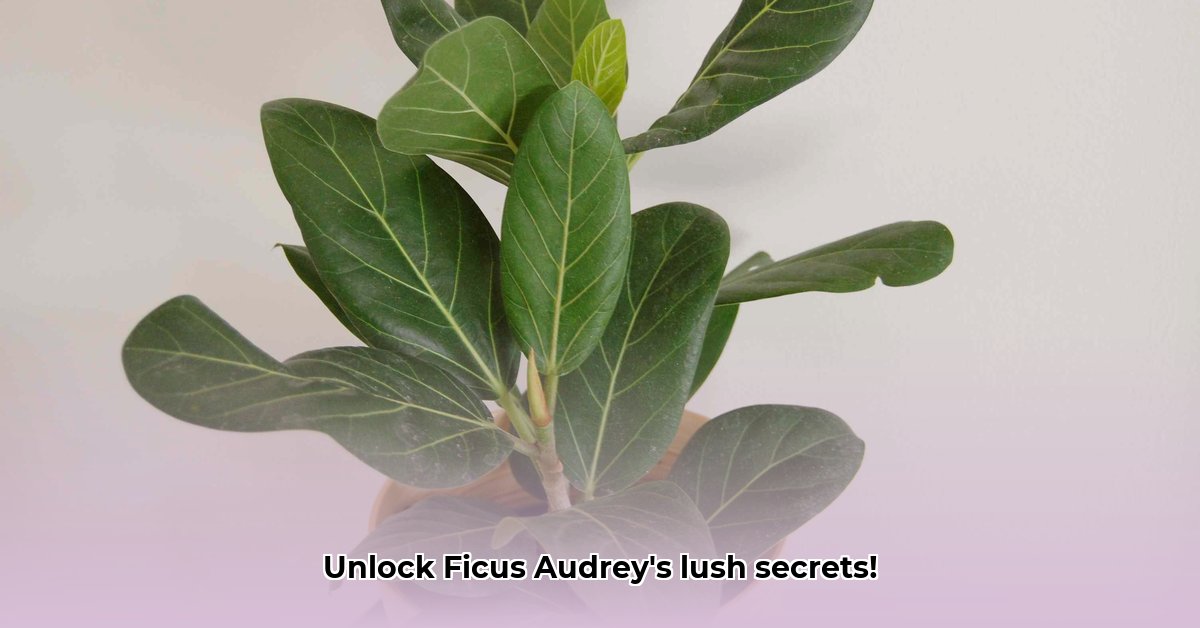Want to infuse your home with natural elegance and enjoy a rewarding plant-parenting experience? Look no further than the Ficus Audrey (Ficus benghalensis)! This stunning houseplant, often called the Indian Banyan Tree, boasts a graceful silhouette and lush, velvety leaves. It’s also wonderfully adaptable, making it an excellent choice for both budding and seasoned plant enthusiasts.
This comprehensive guide provides you with all the essential knowledge to cultivate a flourishing Ficus Audrey. From understanding its specific needs to mastering the art of propagation, we’ll cover every aspect of care to ensure your leafy companion thrives for years to come.
Understanding the Ficus Audrey
The Ficus Audrey, also known as the Bengal Fig, is native to India and Pakistan. In its natural habitat, it can grow to an astounding height of over 100 feet, developing characteristic aerial roots that descend from its branches to form additional trunks, creating a sprawling, majestic canopy. While your indoor Ficus Audrey won’t reach such epic proportions, it will bring a touch of the tropics to your living space.
Key Features of Ficus Audrey:
- Elegant Appearance: Upright growth habit with a single trunk and a canopy of oval-shaped, deep green leaves.
- Velvety Texture: Leaves have a slightly fuzzy texture, adding to their visual appeal.
- Adaptable Nature: More forgiving than other Ficus varieties like the Fiddle Leaf Fig, making it suitable for a range of indoor environments.
- Air-Purifying Qualities: Helps to improve indoor air quality by removing toxins.
Important Note: All parts of the Ficus Audrey are considered toxic if ingested. Keep it out of reach of children and pets.
Optimizing Light and Location
Sunlight is crucial for robust growth. However, Ficus Audrey thrives in bright, indirect light. Direct sunlight, especially during the hottest part of the day, can scorch the leaves, leading to unsightly brown spots.
Ideal Light Conditions:
- East-facing window: Provides gentle morning sunlight.
- West-facing window: Offers bright afternoon light, but shield the plant during peak hours.
- North-facing window: Can work, but you may need to supplement with artificial light, especially during winter.
Signs of Insufficient Light:
- Leggy growth: Long, weak stems with sparse foliage.
- Small leaves: Reduced leaf size.
- Leaf drop: Excessive shedding of leaves.
Tips for Placement:
- Rotate your plant regularly (every few weeks) to ensure even growth on all sides.
- Avoid placing your Ficus Audrey near drafts from doors, windows, or air conditioning vents, as these can cause stress.
Mastering Watering Techniques
Watering correctly is essential for preventing common problems such as root rot and leaf drop. The key is to find the right balance – neither overwatering nor underwatering.
Watering Guidelines:
- Allow the top 1-2 inches of soil to dry out completely before watering.
- Insert your finger into the soil to check the moisture level.
- Water thoroughly until excess water drains from the drainage holes in the pot.
- Discard any excess water that accumulates in the saucer to prevent root rot.
Factors Affecting Watering Frequency:
- Pot size: Smaller pots dry out faster than larger pots.
- Season: Water more frequently during the active growing season (spring and summer) and less during the dormant season (fall and winter).
- Humidity: Lower humidity levels cause the soil to dry out more quickly.
Signs of Overwatering:
- Yellowing leaves: Especially on the lower part of the plant.
- Drooping leaves: Despite the soil being wet.
- Root rot: Soft, mushy, dark brown roots.
- Fungus gnats: Small, flying insects that thrive in damp soil.
Signs of Underwatering:
- Brown, crispy leaf edges.
- Leaf drop.
- Dry, shriveled soil.
Selecting the Right Soil and Fertilizer
The right soil provides proper drainage, aeration, and nutrients. The wrong soil retains too much moisture, leading to root rot.
Ideal Potting Mix:
- A well-draining potting mix specifically formulated for indoor plants.
- A mix of equal parts peat moss, perlite, and coco coir.
Fertilizing Your Plant:
- During the active growing season (spring and summer), fertilize your Ficus Audrey monthly with a balanced liquid houseplant fertilizer.
- Dilute the fertilizer to half strength to avoid burning the roots.
- Do not fertilize during the dormant season (fall and winter).
Pruning for Shape and Health
Pruning is essential for maintaining the shape of your Ficus Audrey, encouraging bushier growth, and removing any dead or diseased branches.
Pruning Techniques:
- Use clean, sharp pruning shears.
- Remove any dead, damaged, or crossing branches.
- Pinch back the tips of new growth to encourage branching.
- Prune in the spring or early summer, during the active growing season.
Identifying and Treating Pests and Diseases
Despite being relatively pest-resistant, Ficus Audrey can be susceptible to common houseplant pests such as mealybugs, spider mites, and scale.
Common Pests:
- Mealybugs: Cottony white insects that suck sap from the plant.
- Spider mites: Tiny, red mites that create webs on the leaves.
- Scale: Small, armored insects that attach themselves to stems and leaves.
Treatment:
- Isolate the affected plant to prevent the pests from spreading.
- Wipe down the leaves and stems with a damp cloth or cotton swab dipped in rubbing alcohol.
- Spray the plant with neem oil or insecticidal soap.
Root Rot:
- Caused by overwatering and poor drainage.
- Repot the plant in fresh, well-draining soil, removing any affected roots.
Propagating Your Ficus Audrey
Propagating your Ficus Audrey is a rewarding way to expand your plant collection or share cuttings with friends. The easiest method is stem cuttings.
Step-by-Step Propagation Guide:
- Select a Healthy Cutting: Choose a healthy stem cutting that is 4-6 inches long, with at least two leaf nodes.
- Prepare the Cutting: Remove the bottom leaves to prevent rotting.
- Rooting Hormone (Optional): Dip the cut end in rooting hormone to encourage faster root development.
- Plant the Cutting: Plant the cutting in a moist potting mix suitable for propagation.
- Create Humidity: Cover the pot with a plastic bag or humidity dome to increase humidity.
- Provide Light and Warmth: Place the cutting in bright, indirect light and a warm environment.
- Be Patient: Roots should develop within a few weeks. Once the roots are established, you can transplant the cutting into a larger pot.
Repotting for Continued Growth
Repotting is necessary when your Ficus Audrey outgrows its current pot, typically every 2-3 years.
Repotting Guidelines:
- Choose a pot that is one or two inches larger in diameter than the current pot.
- Gently remove the plant from its current pot, loosening the roots.
- Place the plant in the new pot with fresh potting mix.
Troubleshooting Common Issues
| Problem | Possible Causes | Solutions |
|---|---|---|
| Leaf drop | Overwatering, underwatering, low light, temperature stress, sudden changes | Adjust watering, provide adequate light, maintain stable temperatures, avoid sudden changes |
| Yellowing leaves | Overwatering, nutrient deficiency, pest infestation | Adjust watering, fertilize during growing season, inspect for pests and treat accordingly |
| Brown leaf edges | Low humidity, dry air, fertilizer burn | Increase humidity by misting the plant or using a humidifier, ensure proper watering, reduce fertilizer use |
| Leggy growth | Insufficient light | Move the plant to a brighter location, supplement with artificial light |
| Stunted growth | Lack of nutrients, root-bound plant | Fertilize during the growing season, repot into a larger container |
| Pest infestation | Unhygienic conditions, introduction from other plants | Isolate affected plant, wash leaves with soapy water, use neem oil or insecticidal soap |
| Root rot | Overwatering, poor drainage | Repot in fresh, well-draining soil, remove affected roots, adjust watering frequency |
Enjoying Your Thriving Ficus Audrey
With proper care and attention, your Ficus Audrey will thrive and bring beauty and tranquility to your home. By following the guidelines in this comprehensive guide, you’ll be well-equipped to provide your leafy companion with the optimal conditions for growth and longevity.
Remember that every plant is unique, so observe your Ficus Audrey closely and adjust your care routine as needed. With a little patience and dedication, you’ll be rewarded with a vibrant and healthy plant that will enhance your living space for years to
- Gluten Free Meal Prep Ideas for Delicious, Hassle-Free Eating - November 28, 2025
- Gluten Free Meal Prep for Stress-Free and Healthy Eating - November 27, 2025
- Quick And Easy Chicken Thigh Meal Prep For Weight Loss - November 26, 2025










